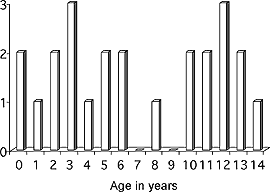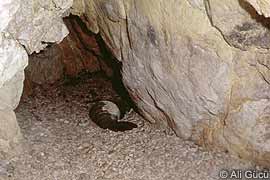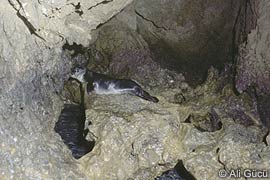

 |
||
 |
||
Vol. 6 (2): December 2003 |
Download this article
|
|
THE CILICIAN MONK SEAL COLONY IS GROWINGAli Cemal GucuMiddle East Technical University, Institute of Marine Sciences
|
||||||||
 |
|
Figure 1. Estimated demographic structure of the Cilician monk seal colony (after Gucu et al. 2004). |
Two major threats may be considered for reduced monk seal reproduction: pollution and lack of food. Pollutants, which may adversely affect reproductive success, such as heavy metals, PAH, and PCBs and insecticides, were not found in high concentration in the region. However, some new research results called attention to evidence of chronic lack of food in seals in the Aegean Sea. The increase in the industrial fishing power in the Cilician Basin and the subsequent reduction in the total catch of main target species is at an alarming level. The lack of food might therefore be linked to low reproduction rate and should be seriously considered as a threat to the survival of the colony.
Evaluation of the research results also indicated that the breeding sites of the Cilician monk seal colony have specific characteristics. Features common to all caves in which whelping was observed included: an entrance with a barrier against strong waves; a deep and wide beach located at the very far end; and a shallow protected pool in front. The cave floor texture also gradually changed seaward from coarse gravel to fine sand. These features seemed to be the distinguishing cave characteristics, which provided a safe and suitable whelping and nursing habitat. Whelping did not occur in all active caves, probably because they lacked a beach and/or a pool inside and protection against storms and strong waves. In active caves, seals only hauled-out and slept on the narrow and flat rock platforms. Furthermore, the presence of a protected pool inside all the breeding caves provided a safe area for neonates to learn how to swim and to keep cool during warm weather conditions. The caves having these characteristics were very few and therefore it seemed that the number and size of suitable caves were limiting factors for reproduction success.
 |
 |
|
|
Figures 2 & 3. Seal caves with typical characteristics in the Cilician Basin. |
||
The scarcity and importance of breeding caves and the dwindling state of the fish stocks are the main concerns in developing the conservation strategy designed and applied in the region. Two core zones, covering the near vicinity of the breeding caves, and a large fishery regulation zone in which only small-scale fishing operations by local artesanal fishermen are allowed, were designated along the Cilician coast in 1999. With this approach, young seals are protected against entanglement in fishing nets. Although some illegal trawling still occurs, the previously heavy fishing pressure on fish stocks has also been remarkably reduced. More importantly, the local small-scale fishermen, who are indebted to the seals for their exclusive coastal resource use rights, no longer see the seals as a pest to exterminate.
The conservation strategy applied aims solely in habitat protection. To what extent these measures will ultimately affect intrinsic population dynamism can hardly be foreseen and worrying questions like:
can best be answered by the colony itself.
Full of promise, the 2003 whelping season helped to diminish our concerns about the fate of the colony. First, one of the earliest pups found by the project team has reached maturity and has given birth to her first healthy pup in the cave where she was born. This is a significant event, signaling the efficient sharing of a breeding habitat among several reproducing individuals.
The second pup was found in a cave in which whelping had not previously been observed. The new cave meets the breeding cave criteria listed above, but was not frequently used until recently. We hope that, as the colony grows, recruits in search of new breeding sites will expand the range of the colony.
Gucu A.C. and F. Erkan. 1999. Preliminary survey report of the monitoring project on the recovery rate of a once deteriorated ecosystem recently designated as a protected area. Phase I. Detrimental effects of trawl fishery on the fish stocks on a narrow continental shelf. Unpublished report to Turkish Ministry of Agriculture and Rural Affairs [in Turkish].
Gucu A.C., G. Gucu and H. Örek. 2004. Habitat use and preliminary demographic evaluation of the critically endangered Mediterranean monk seal (Monachus monachus) in the Cilician Basin (Eastern Mediterranean). Biological Conservation 16 (3): 417-431. [Abstract]
Kideys A.E and I. Salihoglu. 1988. Polychlorinated biphenyls in the sea water off Erdemli - Cilician Basin. Rapports. Commission Internationale pour L’Exploration Scientifique de la Mer Mediterranee, Monaco 31 (2): 142.
Kideys A.E. and M. Unsal. 1988. Seasonality of PCBs in plankton off Erdemli, North-eastern Mediterranean. Environmental Sciences and Technologies Conference, 5–9 June 1988, Izmir-Turkey.
Kompanje E.J.O., H. Güçlüsoy and P.J.H. van Bree. 2000. Insufficient calcium intake as a possible cause of osteoporosis in an adult female monk seal Monachus monachus from Çesme, Turkey. The Monachus Guardian 3 (1) May 2000: 27–28. Internet: www.monachus-guardian.org/mguard05/05scien1.htm.
Yediler A., A. Panou and P. Schramel. 1993. Heavy metals in hair samples of the Mediterranean monk seal (Monachus monachus). Marine Pollution Bulletin 26 (3): 156–159.
Yilmaz A., C. Saydam, S. Ozturk and I. Salihoglu. 1991. Transport of dissolved/dispersed petroleum hydrocarbons in the north-eastern Mediterranean. Toxicology and Environmental Chemistry 31/32: 187–197.
Copyright © 2003 Ali Cemal Gucu, The Monachus Guardian. All Rights Reserved |